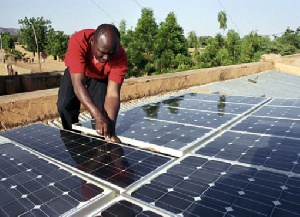It would cost government more than US$420 million to roll out solar power generation in all second cycle schools across the country.
This amount, however, would not include subsequent maintenance of the equipment.
The Deputy Director of Renewable Energy at the Ministry of Energy, Seth Mahu who disclosed this indicated that government is looking for “a more sustainable funding mechanism” to be able to roll out this programme.
“We have counted more than 500 secondary schools already in Ghana from the Ministry of Education’s database. On the average if we are to give each of these secondary schools 100 KW of solar, we’ll need approximately US$420 million. This will be the initial investment, however, you’ll have to change certain components over time,” he said.
Mr. Mahu said running such a programme involves a lot of costs which government or the institutions will not be able to bear without a sustainable funding source.
“We have done some pilot project at the University of Ghana where we have close to one megawatt of solar system there. But I must be honest with you; it’s quite expensive managing that infrastructure.
The university itself does not have enough liquidity to manage it effectively, neither does government. So we need to make sure that we don’t find ourselves in that problem,” he added.
Government has a target to have renewable energy constituting 10 percent of the country’s generation mix by 2020. There’s also a plan to have government institutions supplementing their energy source with solar generated power.
Presently, less than 1% of electricity consumed locally is from renewable energy sources, a statistic players in the industry find worrying.
Parliament last month ratified the framework Agreement on the Establishment of the International Solar Alliance (ISA).
This means Ghana will be joining some 121 countries to access US$2 billion from the Indian government towards making renewable energy a reliable alternative to the more expensive sources of energy on the continent.
With this ratification, government hopes to expedite the integration of renewable energy in the sources for electricity among its institutions and agencies, including Junior and Senior High Schools.
Business News of Tuesday, 24 October 2017
Source: thebftonline.com













